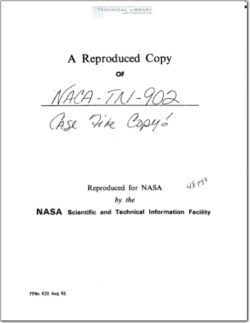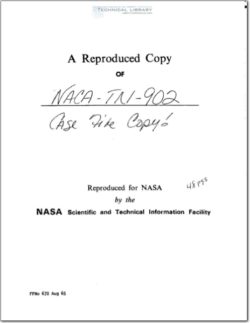NACA-TN-902

- Version
- 1505 Downloads
- 2.31 MB File Size
- 1 File Count
- December 4, 2015 Create Date
- December 4, 2015 Last Updated
Description of Stress Strain Curve by Three Parameters - Ramberg Osgood

An assembly of the tensile and compressive stress—
strain curves for sheet materials characteristic of air—
craft construction is being obtained at the National
Bureau of standards as the principal objective of a re—
search project for the National Advisory Committee for
Aeronautics. stress-strain, stress-deviation, secant—
modulus. tangent-modulus, and reduced-modulus curves have
been presented in reference 1 for various_grades of sheet
materials of aluminum alloy, carbon steel, and chromium~
nickel steel. A second objective of the same research
project is a search for yield parameters that give a better
description of the stress—strain curve than those in use
at present.
The conventional description of the stress-strain.
icurve of metals by the two parameters. Young's modulus_and
iyield strength, is-inadequate for the efficient design of
-Ni members unless the material follows Hooke’s law up to a
yield point at which it yields indefinitely under constant
stress. This special behavior is approached, for example,
by certain steels (fig. 1) and by certain low—strength
magnesium alloys, but it is not characteristic of many.
high-strength alloys for aircraft.
Examination of the stress-strain curves for aluminum—
alloy sheet and chromium-nickel-steel sheet given in ref—
erence 1 shows, particularly for the compressive stress-
strain curves (figs. 2 and 3), a gradual transition from
the elastic straight line for low loads toward the horizon-
tal line characterizing plastic behavior. The type of
transition varies widely. Hence there is no hope of reduc~
ing all stress-strain curves to a single type of curve by
uniform stretching. or affine transformation of coordinatese
This rules out the possibility, which exists for affinely
related stress-strain curves (reference 2); of complete
adescription in terms of only two parameters. Young's mod-
ulus and secant yield strength. A minimum of three param—
stars will be required to describe the changes in shape
for different materials.
| File | Action |
|---|---|
| naca-tn-902.pdf | Download |

Comment On This Post